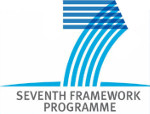Uncapped gold nanoparticles for the metallization of organic monolayers
Martín-Barreiro, Alba ; Soto, Rogelio ; Chiodini, Stefano ; García-Serrano, Aitor (Universidad de Zaragoza) ; Martín, Santiago (Universidad de Zaragoza) ; Herrer, Lucia (Universidad de Zaragoza) ; Pérez-Murano, Francesc ; Low, Paul J. ; Serrano, José Luis (Universidad de Zaragoza) ; de Marcos, Susana (Universidad de Zaragoza) ; Galban, Javier (Universidad de Zaragoza) ; Cea, Pilar (Universidad de Zaragoza)
Resumen: Deposition of the top-contact electrode to create large-area electrode | monolayer | electrode junctions represents a contemporary challenge to the integration of molecular electronic phenomena into device structures. Here, a top contact electrode is formed on top of an organic monolayer over a large area (cm2) by two simple, sequential self-assembly steps. Initial self-assembly of 4,4′-(1,4-phenylenebis(ethyne-2,1-diyl))dianiline onto gold-on-glass substrates gives high-quality monolayers. The exposed amine functionality is subsequently used to anchor uncapped gold nanoparticles deposited in a second self-assembly step. These uncapped gold nanoparticles are prepared by thermolysis of lipoic acid stabilized gold nanoclusters and contain gold oxide (≈9%) that provides stability in the absence of an organic capping ligand. This two-step procedure results in full coverage of the monolayer by the densely packed gold nanoparticles, which spontaneously condense to give a semi-continuous film. The electrical properties of these junctions are determined from I–V curves, revealing uniform electrical response and absence of metallic short-circuits or evidence of damage to the underlying molecular monolayer. These promising electrical characteristics suggest that the deposition of uncapped gold nanoparticles on suitably functionalized molecular monolayers provides a path for the fabrication of molecular electronic devices using simple methodologies.
Idioma: Inglés
DOI: 10.1002/admi.202100876
Año: 2021
Publicado en: Advanced Materials Interfaces 8, 18 (2021), 2100876 [10 pp.]
ISSN: 2196-7350
Factor impacto JCR: 6.389 (2021)
Categ. JCR: MATERIALS SCIENCE, MULTIDISCIPLINARY rank: 95 / 345 = 0.275 (2021) - Q2 - T1
Categ. JCR: CHEMISTRY, MULTIDISCIPLINARY rank: 48 / 180 = 0.267 (2021) - Q2 - T1
Factor impacto CITESCORE: 9.1 - Engineering (Q1)
Factor impacto SCIMAGO: 1.421 - Mechanics of Materials (Q1) - Mechanical Engineering (Q1)
Financiación: info:eu-repo/grantAgreement/ES/DGA/E25-17R
Financiación: info:eu-repo/grantAgreement/ES/DGA/E31-20R
Financiación: info:eu-repo/grantAgreement/ES/DGA/E47-17R
Financiación: info:eu-repo/grantAgreement/EC/FP7/607602/EU/Hierarchical Self Assembly of Polymeric Soft Systems/SASSYPOL
Financiación: info:eu-repo/grantAgreement/ES/MCIU-FEDER/PGC2018-097583-B-I00
Financiación: info:eu-repo/grantAgreement/ES/MCIU/PID2019-105408GB-I00
Financiación: info:eu-repo/grantAgreement/ES/MCIU/PID2019-105881RB-I00
Tipo y forma: Artículo (Versión definitiva)
Área (Departamento): Área Química Analítica (Dpto. Química Analítica)
Área (Departamento): Área Química Orgánica (Dpto. Química Orgánica)
Área (Departamento): Área Química Física (Dpto. Química Física)
 Debe reconocer adecuadamente la autoría, proporcionar un enlace a la licencia e indicar si se han realizado cambios. Puede hacerlo de cualquier manera razonable, pero no de una manera que sugiera que tiene el apoyo del licenciador o lo recibe por el uso que hace. No puede utilizar el material para una finalidad comercial. Si remezcla, transforma o crea a partir del material, no puede difundir el material modificado.
Debe reconocer adecuadamente la autoría, proporcionar un enlace a la licencia e indicar si se han realizado cambios. Puede hacerlo de cualquier manera razonable, pero no de una manera que sugiera que tiene el apoyo del licenciador o lo recibe por el uso que hace. No puede utilizar el material para una finalidad comercial. Si remezcla, transforma o crea a partir del material, no puede difundir el material modificado.
Exportado de SIDERAL (2023-05-18-14:12:59)
Visitas y descargas
Idioma: Inglés
DOI: 10.1002/admi.202100876
Año: 2021
Publicado en: Advanced Materials Interfaces 8, 18 (2021), 2100876 [10 pp.]
ISSN: 2196-7350
Factor impacto JCR: 6.389 (2021)
Categ. JCR: MATERIALS SCIENCE, MULTIDISCIPLINARY rank: 95 / 345 = 0.275 (2021) - Q2 - T1
Categ. JCR: CHEMISTRY, MULTIDISCIPLINARY rank: 48 / 180 = 0.267 (2021) - Q2 - T1
Factor impacto CITESCORE: 9.1 - Engineering (Q1)
Factor impacto SCIMAGO: 1.421 - Mechanics of Materials (Q1) - Mechanical Engineering (Q1)
Financiación: info:eu-repo/grantAgreement/ES/DGA/E25-17R
Financiación: info:eu-repo/grantAgreement/ES/DGA/E31-20R
Financiación: info:eu-repo/grantAgreement/ES/DGA/E47-17R
Financiación: info:eu-repo/grantAgreement/EC/FP7/607602/EU/Hierarchical Self Assembly of Polymeric Soft Systems/SASSYPOL
Financiación: info:eu-repo/grantAgreement/ES/MCIU-FEDER/PGC2018-097583-B-I00
Financiación: info:eu-repo/grantAgreement/ES/MCIU/PID2019-105408GB-I00
Financiación: info:eu-repo/grantAgreement/ES/MCIU/PID2019-105881RB-I00
Tipo y forma: Artículo (Versión definitiva)
Área (Departamento): Área Química Analítica (Dpto. Química Analítica)
Área (Departamento): Área Química Orgánica (Dpto. Química Orgánica)
Área (Departamento): Área Química Física (Dpto. Química Física)
Exportado de SIDERAL (2023-05-18-14:12:59)
Enlace permanente:
Visitas y descargas
Este artículo se encuentra en las siguientes colecciones:
Artículos > Artículos por área > Química Analítica
Artículos > Artículos por área > Química Orgánica
Artículos > Artículos por área > Química Física
Registro creado el 2021-11-22, última modificación el 2023-05-19
